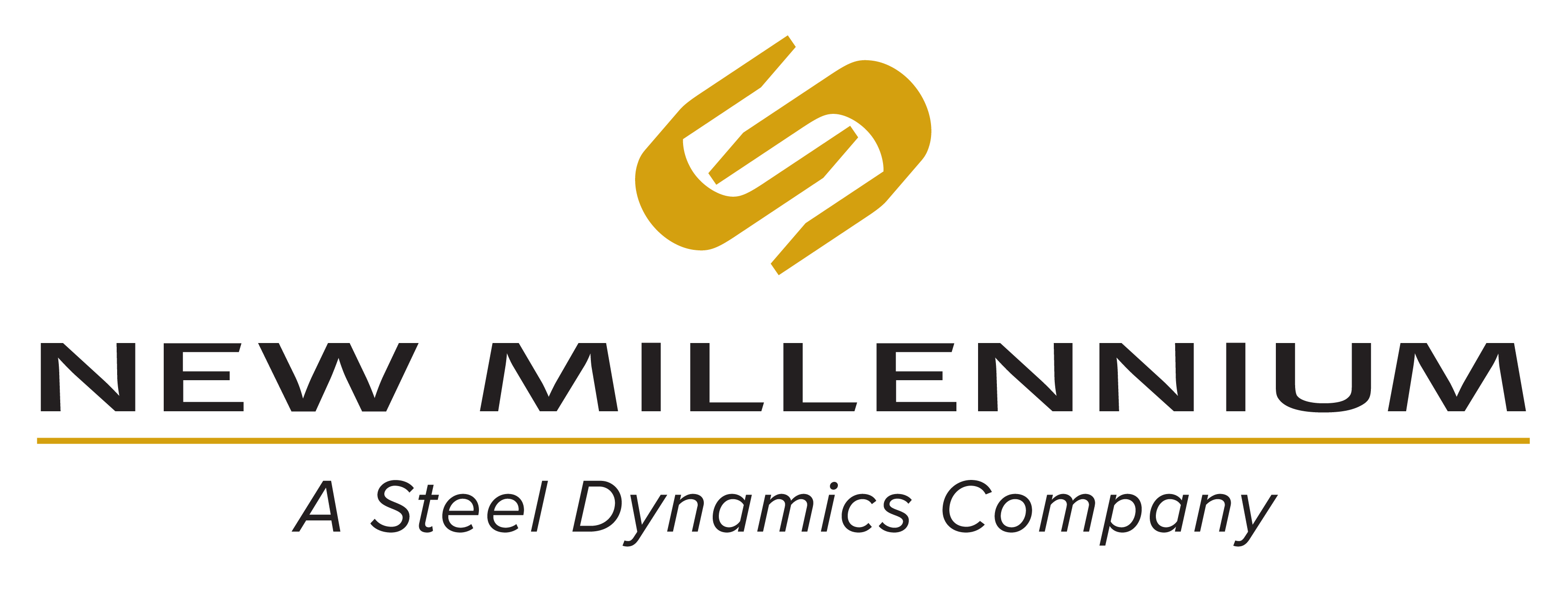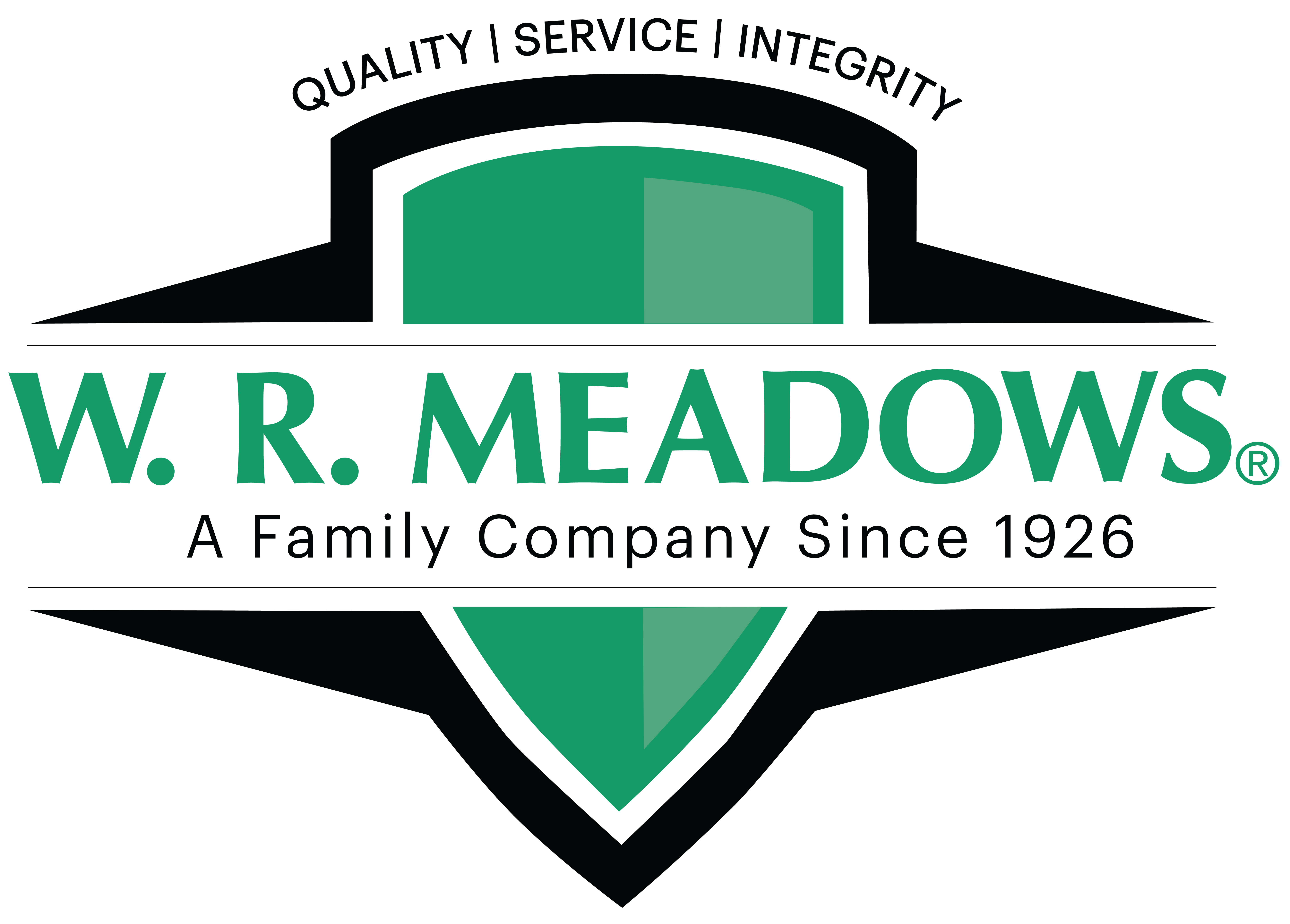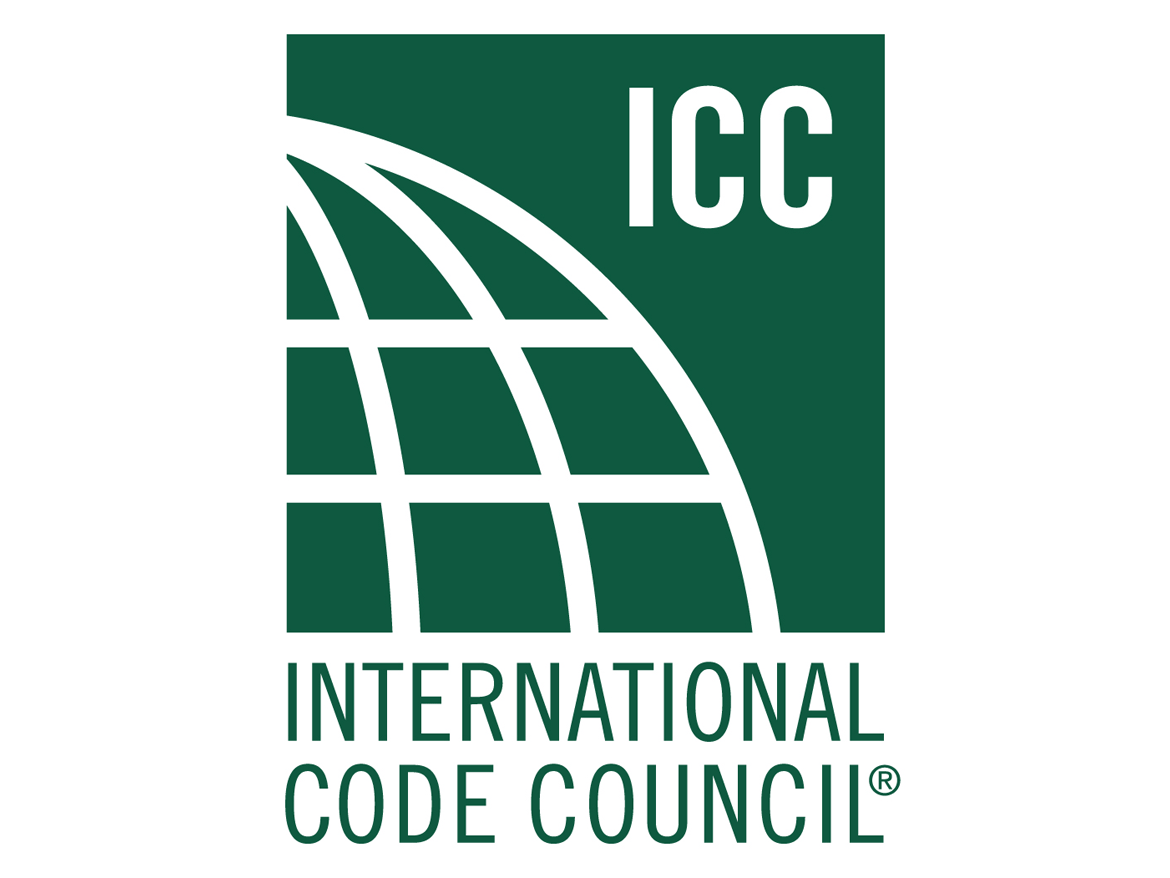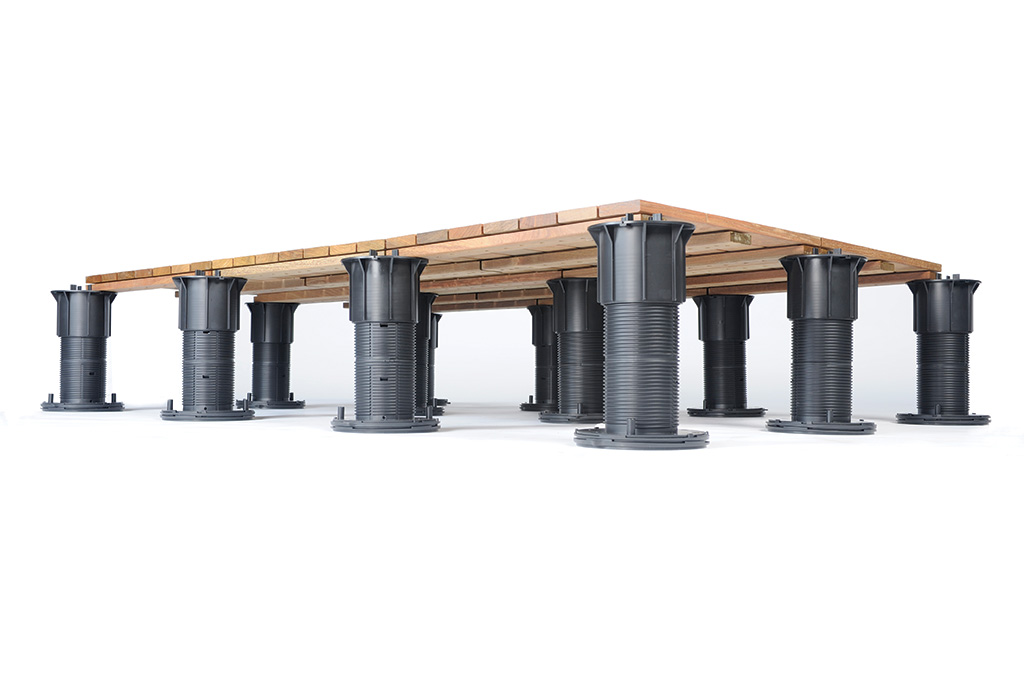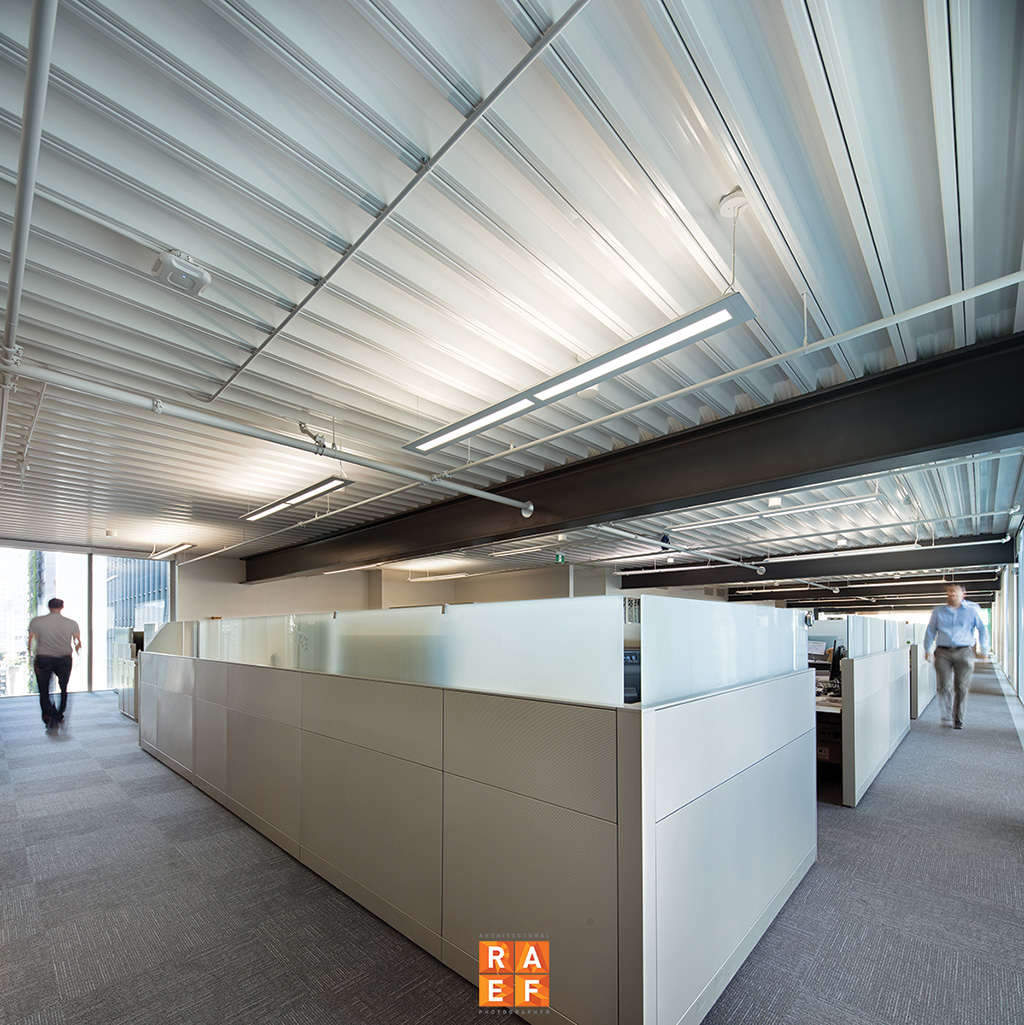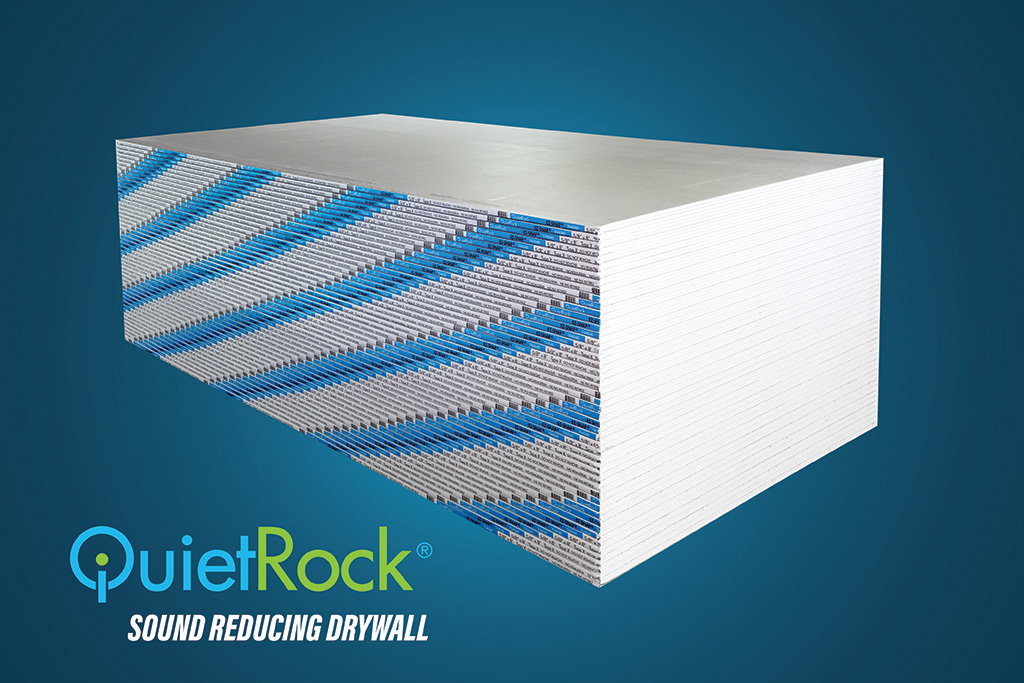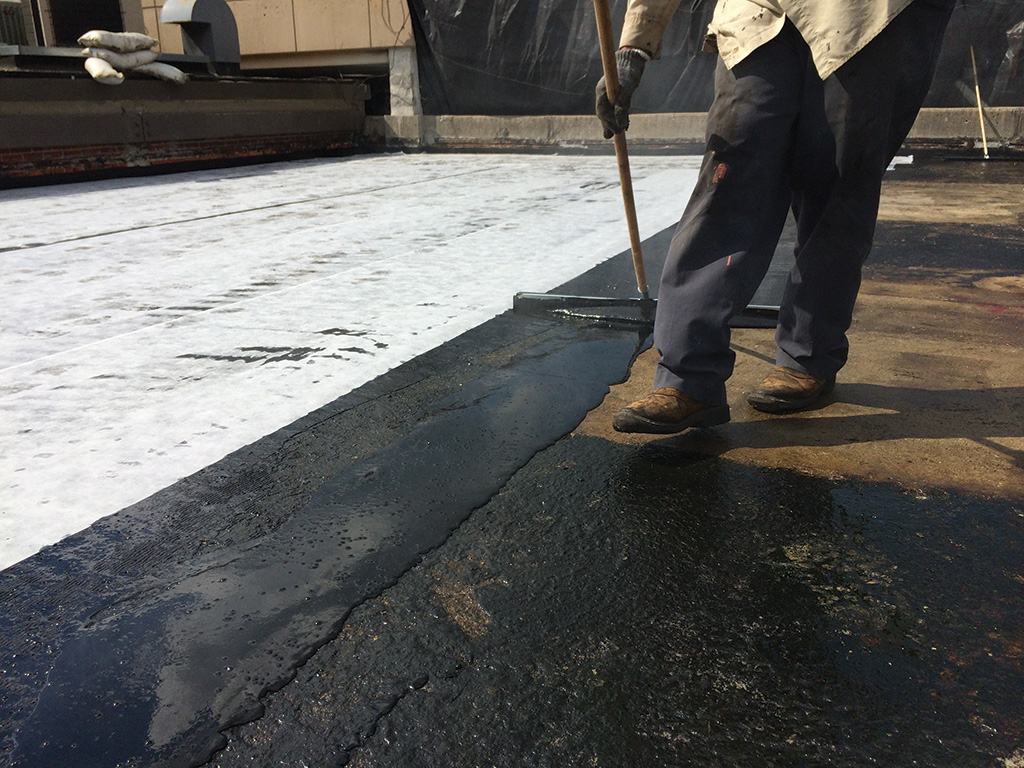
Photo courtesy of PABCO® Gypsum
Addressing the new challenges in healthcare requires innovative solutions, collaboration among stakeholders, and a focus on improving outcomes for patients and providers.
The details are not the details. They make the design.” – Charles Eames
Whether healthcare projects are pursuing high-tech solutions, tapping into natural elements, or focusing on smaller building sizes, the future of healthcare facility design can be distilled to a single goal: projects that improve patient outcomes and nurture employee retention.1 Advances in modern materials are enabling design professionals to better meet these demands in healthcare.
The design movement toward community was encapsulated in the 2024 IIDA Healthcare Design Awards. Nominated spaces showcased innovation, empathy, and design that build fellowship.2 By recognizing the profound impact of the built environment on mood and behavior, nominated projects created spaces where patients and staff felt safe, valued, and heard.3 By embracing these trends, healthcare spaces can become more efficient, patient-centered, and ready for the future.4

Photo © WW Glass LLC; courtesy of New Millennium, A Steel Dynamics Company
Building community in healthcare reaches past the provision of medical services; it involves nurturing a sense of connection and support among patients, families, and providers. White Plains Hospital.
Innovating to Overcome Challenges
Advances in Domestic Steel
Meeting community needs means being adaptable. Designs that demand flexibility, adaptability, and expansion are a natural fit for structural steel. Structural steel provides ubiquity, strength, and a breadth of offerings for the broad-ranging healthcare market segment that encompasses hospitals, medical office buildings, clinics, rehabilitation centers, imaging centers, senior care, and educational facilities. Scale, complexity, demographics, use propensity, and services are among a fraction of the considerations that go into designing this range of building types. Across this wide spectrum, however, there are a few points of consistency: speed of construction, cost, and quality.
Healthcare environments are frequently challenged by exceptionally large structural loads to accommodate equipment, the elaborate networks of building systems, and the need for a sterile environment. Along with planning for point loads, structural designs must confront various slab depressions or thickened areas providing curbs for sophisticated equipment. Racks of pipes and communication lines hung from the ceiling add to the loading, along with chaseway penetrations that are either core-drilled or framed-out openings in the structural bay, all this while not compromising the fire-rating. Additionally, professionals are challenged to maintain thin floor plates that can meet vibration and deflection demands. These stringent requirements, historically packaged in cold, white, and labyrinthine caverns, are now transitioning aesthetically to friendly, welcoming, and resort-like settings. Enabling design professionals to meet these challenges means providing better products and engaging product manufacturers in order to collaborate for success.
Advancements in steel deck offerings, like riveted liner panels and steel joists developing flush-frame connections have made structural steel even more versatile. The intent is to make installation faster, stronger, and safer. Other developments in composite design include asymmetric beams. The American Institute of Steel Construction is engaged in comprehensive studies on these particular beams. They can pair with various floor types, including long-span composite deck. Asymmetric beams are characterized by having the typical bottom flange of a beam with a thick steel stock replacing the top flange. The shape allows for bearing on the bottom flange instead of the top, integrating the beam into the deck slab, reducing the overall depth of the floor system. The top is encased in concrete, minimum 2-inch cover, potentially eliminating the need for fire suppressive coatings. This increases the speed of installation and overall construction schedule.
Product manufacturers have in-house expertise to assist design professionals with their projects. They are steeped in knowledge of steel joists, beams, and deck. This includes product variations, framing efficiencies, detailing considerations, fire-rated assemblies, acoustics, finish coating systems, and sustainability.
Exposed steel deck has standard, cellular (flat-bottom), and dovetail options in composite and acoustical combinations. Factory-applied finishes likewise feature a range of options to suit project requirements: primers, high-performance coatings, and anti-microbial coatings.
From recycled content to energy-efficient manufacturing, products from the domestic steel industry are at the vanguard of sustainable design. Joist and deck manufacturers can highlight transparent chain-of-custody on sourcing materials, plant-specific EPDs, and LEED Recycled Content for design documentation.
The Latest Evolution in Drywall
Several studies have been conducted to pinpoint strategies for improving design in healthcare facilities. The specification of noise-reducing materials is a key recommendation.5 Choosing the appropriate wall design is one solution that can help support patient privacy while minimizing noise transmission.
To better reduce noise transmission from one space to another, new drywall products are available that support noise-reducing wall designs. These panels reduce noise by using constrained-layer damping (CLD) technology. CLD panels contain a viscoelastic polymer layer that allows the gypsum layers to independently shear, dissipating the acoustic energy of the sound wave. This results in less audible energy passing through the board, in essence reducing the sound transfer between rooms.

Figure courtesy of PABCO® Gypsum
Cross section of a CLD panel.
The most advanced sound-reducing drywall in the industry is a single-panel solution that is engineered for high sound attenuation and fire resistance. CLD panels can be used for new construction or retrofit projects with no demolition required. CLD drywall can provide additional benefits, including attainment of higher STC ratings at a lower installed cost than other sound reduction options; UL/ULC fire-rated walls and tested STC performance in one design; STC performance not affected with headwall systems and mounted fixtures; and increased sustainability via certified low VOC per CDPH Standard. Some CLD products offer additional advantages, including high-impact, mold-resistant, and RF shielding capabilities. By combining these two critical functions into a single panel, the construction process can be streamlined. This all-in-one approach simplifies building codes and requires less space, material, and labor compared to conventional alternatives. This not only makes projects more efficient but also contributes to sustainability by reducing the number of jobsite deliveries and waste. Additionally, most CLD panels install and finish just like standard drywall, with no special tools or training needed.
CLD panels empower wellness. They also provide choice. In patient room applications, performance isn’t affected by headwall systems or mounted fixtures. Some CLD panels offer additional high-impact resistance, mold resistance, RF shielding, and low-frequency tuning options.
Product and Design Advances that Support Green Roofs

Photo courtesy of W.R. Meadows, Inc.
Green roofs create unique new ecosystems full of benefits for the building, its occupants, and the surrounding neighborhood.
A green roof system, as defined by Green Roofs for Healthy Cities, is an extension of the existing roof which involves, at a minimum, high-quality waterproofing, root repellent system, drainage system, filter cloth, a lightweight growing medium, and plants.6 Green roof systems have advanced radically. They may be modular, with drainage layers, filter cloth, growing media, and plants already prepared in movable, often interlocking grids. Alternatively, green roof designs can be loose-laid or built-in-place, whereby each component of the system is installed separately. A green space could be below, at, or above grade, but in all cases, it exists separately from the ground. Green roofs provide a wide range of public and private benefits.
While the initial costs of green roofs can be higher than those of conventional materials, building owners can help offset some of the costs through reduced energy costs and stormwater management fees, and potentially by the longer lifespan of green roofs compared with conventional roofing materials. Green roofs provide relative benefits over a 50-year lifecycle, including reductions in energy use, surrounding temperature, noise pollution, and stormwater runoff.7
There are fundamentals for designing a long-term, thriving, leak-free green roofing system. These include specifying durable roofing, using a Protected Roof Membrane Assembly (PRMA), and ensuring there is no exposed membrane, as this causes accelerated aging. Though often the unsung heroes of a green roof, the layers below the vegetation and growing media are the key to a design’s longevity and reliability. Innovative building materials, including insulation, barriers, membrane systems, and surface conditioners, are designed to work together seamlessly, simplifying the specification and installation process for even the most complex roofing and overburden systems. The waterproofing layer must remain constant to offer unmatched protection and serve as the critical foundation for the entire system, safeguarding the project’s investment for the long term.
Additionally, using Vegetated Free Zones (VFZ) is a vital and innovative strategy. VFZ refers to areas of roofing with no plants or soil that are covered in roof pavers or roof gravel. Critically, VFZ protects roofing elements around all perimeters, flashing, penetrations, and drains. Designing green roofs with VFZ holds back plants and soil to protect flashing from accelerated degradation. This also allows access for maintenance to sensitive flashing. Typical maintenance includes fertilization, irrigation, weed control, and replanting when necessary. Intensive green roofs might require maintenance exceeding that required for extensive roofs to maintain their aesthetic and public access uses. Additionally, backfill with roof pavers or roof gravel over drainage composite protects drains and chambers from blockage. Buried drains can cause ponding water. Best practice for VFZ includes planning these zones around mechanical equipment, access paths, and all flashing and drains.
Innovations that Expand Amenities Outdoors
New products are helping to remove barriers and facilitate the development of natural spaces within healthcare settings. Adjustable pedestal deck systems provide a unique alternative to traditional deck building methods. They deliver tremendous design flexibility, coupled with ease of installation. Pedestal deck supports are designed to elevate a variety of substrates, including porcelain or concrete pavers, wood tiles, composite materials, fiberglass reinforced plastic (FRP) grating, or conventional wood decking systems. These systems are available in a range of heights and weight-bearing capacities to suit a variety of applications. The pedestal system is one of the most labor- and cost-efficient methods of creating a flat, level deck over a sloped sub-surface. They also open the opportunity to use underutilized outdoor spaces, turning an otherwise wasted space into a functional outdoor amenity.
Deck support systems are impervious to water, mold, and freeze-thaw cycles. Pedestal systems can support decks over occupied space, allowing cavity space for electrical systems, ductwork, and irrigation. Pedestals also elevate the deck surface to meet the threshold, delivering an even and level transition from one space to another. This allows easy access for patrons with different levels of mobility. Using a gravity system, the supports additionally protect roofing membranes and waterproofing, and do not damage or harm the surface below. These broad landscape views inspire an emotional attachment to the building’s natural surroundings and promote positive interactions between the building’s users and the neighboring ecosystem.
Pedestal decks can help to reduce a building’s carbon footprint through a reduction in a roof’s ambient temperature, potential for green space, rainwater collection initiatives, and reduced need for roof replacement, avoiding additional construction materials. Where wood tiles are specified, verify the availability of FSC® Certified products. Paver trays provide simple, lightweight, and durable support for porcelain, natural stone, and concrete pavers. Paver trays made from galvanized steel meet the testing requirements for non-combustible surface materials. The paver support trays are designed to enhance the impact and wind uplift resistance and provide additional strength to paver surface materials. Paver trays can be adhered to the desired surface pavers on site before or during installation. Planter cubes integrate with walkways in a modular pedestal deck system, making it easy to design a beautiful outdoor environment. Available with standard irrigation sleeves and drainage holes, cubes can host plant life in the summer and be repurposed for seating and storage in the winter.

Photo courtesy of Bison Innovative Products
Adaptability lies at the heart of modern healthcare design, with spaces crafted to grow and evolve alongside patient needs.

Photo courtesy of PABCO® Gypsum
Addressing the new challenges in healthcare requires innovative solutions, collaboration among stakeholders, and a focus on improving outcomes for patients and providers.
The details are not the details. They make the design.” – Charles Eames
Whether healthcare projects are pursuing high-tech solutions, tapping into natural elements, or focusing on smaller building sizes, the future of healthcare facility design can be distilled to a single goal: projects that improve patient outcomes and nurture employee retention.1 Advances in modern materials are enabling design professionals to better meet these demands in healthcare.
The design movement toward community was encapsulated in the 2024 IIDA Healthcare Design Awards. Nominated spaces showcased innovation, empathy, and design that build fellowship.2 By recognizing the profound impact of the built environment on mood and behavior, nominated projects created spaces where patients and staff felt safe, valued, and heard.3 By embracing these trends, healthcare spaces can become more efficient, patient-centered, and ready for the future.4

Photo © WW Glass LLC; courtesy of New Millennium, A Steel Dynamics Company
Building community in healthcare reaches past the provision of medical services; it involves nurturing a sense of connection and support among patients, families, and providers. White Plains Hospital.
Innovating to Overcome Challenges
Advances in Domestic Steel
Meeting community needs means being adaptable. Designs that demand flexibility, adaptability, and expansion are a natural fit for structural steel. Structural steel provides ubiquity, strength, and a breadth of offerings for the broad-ranging healthcare market segment that encompasses hospitals, medical office buildings, clinics, rehabilitation centers, imaging centers, senior care, and educational facilities. Scale, complexity, demographics, use propensity, and services are among a fraction of the considerations that go into designing this range of building types. Across this wide spectrum, however, there are a few points of consistency: speed of construction, cost, and quality.
Healthcare environments are frequently challenged by exceptionally large structural loads to accommodate equipment, the elaborate networks of building systems, and the need for a sterile environment. Along with planning for point loads, structural designs must confront various slab depressions or thickened areas providing curbs for sophisticated equipment. Racks of pipes and communication lines hung from the ceiling add to the loading, along with chaseway penetrations that are either core-drilled or framed-out openings in the structural bay, all this while not compromising the fire-rating. Additionally, professionals are challenged to maintain thin floor plates that can meet vibration and deflection demands. These stringent requirements, historically packaged in cold, white, and labyrinthine caverns, are now transitioning aesthetically to friendly, welcoming, and resort-like settings. Enabling design professionals to meet these challenges means providing better products and engaging product manufacturers in order to collaborate for success.
Advancements in steel deck offerings, like riveted liner panels and steel joists developing flush-frame connections have made structural steel even more versatile. The intent is to make installation faster, stronger, and safer. Other developments in composite design include asymmetric beams. The American Institute of Steel Construction is engaged in comprehensive studies on these particular beams. They can pair with various floor types, including long-span composite deck. Asymmetric beams are characterized by having the typical bottom flange of a beam with a thick steel stock replacing the top flange. The shape allows for bearing on the bottom flange instead of the top, integrating the beam into the deck slab, reducing the overall depth of the floor system. The top is encased in concrete, minimum 2-inch cover, potentially eliminating the need for fire suppressive coatings. This increases the speed of installation and overall construction schedule.
Product manufacturers have in-house expertise to assist design professionals with their projects. They are steeped in knowledge of steel joists, beams, and deck. This includes product variations, framing efficiencies, detailing considerations, fire-rated assemblies, acoustics, finish coating systems, and sustainability.
Exposed steel deck has standard, cellular (flat-bottom), and dovetail options in composite and acoustical combinations. Factory-applied finishes likewise feature a range of options to suit project requirements: primers, high-performance coatings, and anti-microbial coatings.
From recycled content to energy-efficient manufacturing, products from the domestic steel industry are at the vanguard of sustainable design. Joist and deck manufacturers can highlight transparent chain-of-custody on sourcing materials, plant-specific EPDs, and LEED Recycled Content for design documentation.
The Latest Evolution in Drywall
Several studies have been conducted to pinpoint strategies for improving design in healthcare facilities. The specification of noise-reducing materials is a key recommendation.5 Choosing the appropriate wall design is one solution that can help support patient privacy while minimizing noise transmission.
To better reduce noise transmission from one space to another, new drywall products are available that support noise-reducing wall designs. These panels reduce noise by using constrained-layer damping (CLD) technology. CLD panels contain a viscoelastic polymer layer that allows the gypsum layers to independently shear, dissipating the acoustic energy of the sound wave. This results in less audible energy passing through the board, in essence reducing the sound transfer between rooms.

Figure courtesy of PABCO® Gypsum
Cross section of a CLD panel.
The most advanced sound-reducing drywall in the industry is a single-panel solution that is engineered for high sound attenuation and fire resistance. CLD panels can be used for new construction or retrofit projects with no demolition required. CLD drywall can provide additional benefits, including attainment of higher STC ratings at a lower installed cost than other sound reduction options; UL/ULC fire-rated walls and tested STC performance in one design; STC performance not affected with headwall systems and mounted fixtures; and increased sustainability via certified low VOC per CDPH Standard. Some CLD products offer additional advantages, including high-impact, mold-resistant, and RF shielding capabilities. By combining these two critical functions into a single panel, the construction process can be streamlined. This all-in-one approach simplifies building codes and requires less space, material, and labor compared to conventional alternatives. This not only makes projects more efficient but also contributes to sustainability by reducing the number of jobsite deliveries and waste. Additionally, most CLD panels install and finish just like standard drywall, with no special tools or training needed.
CLD panels empower wellness. They also provide choice. In patient room applications, performance isn’t affected by headwall systems or mounted fixtures. Some CLD panels offer additional high-impact resistance, mold resistance, RF shielding, and low-frequency tuning options.
Product and Design Advances that Support Green Roofs

Photo courtesy of W.R. Meadows, Inc.
Green roofs create unique new ecosystems full of benefits for the building, its occupants, and the surrounding neighborhood.
A green roof system, as defined by Green Roofs for Healthy Cities, is an extension of the existing roof which involves, at a minimum, high-quality waterproofing, root repellent system, drainage system, filter cloth, a lightweight growing medium, and plants.6 Green roof systems have advanced radically. They may be modular, with drainage layers, filter cloth, growing media, and plants already prepared in movable, often interlocking grids. Alternatively, green roof designs can be loose-laid or built-in-place, whereby each component of the system is installed separately. A green space could be below, at, or above grade, but in all cases, it exists separately from the ground. Green roofs provide a wide range of public and private benefits.
While the initial costs of green roofs can be higher than those of conventional materials, building owners can help offset some of the costs through reduced energy costs and stormwater management fees, and potentially by the longer lifespan of green roofs compared with conventional roofing materials. Green roofs provide relative benefits over a 50-year lifecycle, including reductions in energy use, surrounding temperature, noise pollution, and stormwater runoff.7
There are fundamentals for designing a long-term, thriving, leak-free green roofing system. These include specifying durable roofing, using a Protected Roof Membrane Assembly (PRMA), and ensuring there is no exposed membrane, as this causes accelerated aging. Though often the unsung heroes of a green roof, the layers below the vegetation and growing media are the key to a design’s longevity and reliability. Innovative building materials, including insulation, barriers, membrane systems, and surface conditioners, are designed to work together seamlessly, simplifying the specification and installation process for even the most complex roofing and overburden systems. The waterproofing layer must remain constant to offer unmatched protection and serve as the critical foundation for the entire system, safeguarding the project’s investment for the long term.
Additionally, using Vegetated Free Zones (VFZ) is a vital and innovative strategy. VFZ refers to areas of roofing with no plants or soil that are covered in roof pavers or roof gravel. Critically, VFZ protects roofing elements around all perimeters, flashing, penetrations, and drains. Designing green roofs with VFZ holds back plants and soil to protect flashing from accelerated degradation. This also allows access for maintenance to sensitive flashing. Typical maintenance includes fertilization, irrigation, weed control, and replanting when necessary. Intensive green roofs might require maintenance exceeding that required for extensive roofs to maintain their aesthetic and public access uses. Additionally, backfill with roof pavers or roof gravel over drainage composite protects drains and chambers from blockage. Buried drains can cause ponding water. Best practice for VFZ includes planning these zones around mechanical equipment, access paths, and all flashing and drains.
Innovations that Expand Amenities Outdoors
New products are helping to remove barriers and facilitate the development of natural spaces within healthcare settings. Adjustable pedestal deck systems provide a unique alternative to traditional deck building methods. They deliver tremendous design flexibility, coupled with ease of installation. Pedestal deck supports are designed to elevate a variety of substrates, including porcelain or concrete pavers, wood tiles, composite materials, fiberglass reinforced plastic (FRP) grating, or conventional wood decking systems. These systems are available in a range of heights and weight-bearing capacities to suit a variety of applications. The pedestal system is one of the most labor- and cost-efficient methods of creating a flat, level deck over a sloped sub-surface. They also open the opportunity to use underutilized outdoor spaces, turning an otherwise wasted space into a functional outdoor amenity.
Deck support systems are impervious to water, mold, and freeze-thaw cycles. Pedestal systems can support decks over occupied space, allowing cavity space for electrical systems, ductwork, and irrigation. Pedestals also elevate the deck surface to meet the threshold, delivering an even and level transition from one space to another. This allows easy access for patrons with different levels of mobility. Using a gravity system, the supports additionally protect roofing membranes and waterproofing, and do not damage or harm the surface below. These broad landscape views inspire an emotional attachment to the building’s natural surroundings and promote positive interactions between the building’s users and the neighboring ecosystem.
Pedestal decks can help to reduce a building’s carbon footprint through a reduction in a roof’s ambient temperature, potential for green space, rainwater collection initiatives, and reduced need for roof replacement, avoiding additional construction materials. Where wood tiles are specified, verify the availability of FSC® Certified products. Paver trays provide simple, lightweight, and durable support for porcelain, natural stone, and concrete pavers. Paver trays made from galvanized steel meet the testing requirements for non-combustible surface materials. The paver support trays are designed to enhance the impact and wind uplift resistance and provide additional strength to paver surface materials. Paver trays can be adhered to the desired surface pavers on site before or during installation. Planter cubes integrate with walkways in a modular pedestal deck system, making it easy to design a beautiful outdoor environment. Available with standard irrigation sleeves and drainage holes, cubes can host plant life in the summer and be repurposed for seating and storage in the winter.

Photo courtesy of Bison Innovative Products
Adaptability lies at the heart of modern healthcare design, with spaces crafted to grow and evolve alongside patient needs.
Benefiting Communal Health through Nature
The connection of nature to health and the human experience is overwhelming. Providing a healing garden or a green roof extends the healthcare space and provides a place for social connectivity as well as connectivity to the natural world. Regular interactions with the outdoors are proven to lower blood pressure, reduce stress, expedite healing, and improve a person’s mood and focus. More than fifty published studies highlight natural daylight and views of nature as key factors that contribute to faster patient recovery, lower medication reliance, reduced stress for staff and families, and enhanced emotional well-being.
Eliminating Boundaries
Fundamental to a holistic design approach in healthcare is the concept of biophilia. Biophilic design is a design philosophy that encourages the use of natural systems and processes in the design of the built environment.8 Hospital design plays a tangible role in the restoration of patients. “Biophilic design is more complex and richer than the mere application of vegetation in buildings; it broadens the variety through encompassing different types of nature from physical, sensory, metaphorical, morphological, material to spiritual.”9 The built environment and nature can no longer be viewed as distinct, or even opposing, spaces. For the health of occupants, a joining of what lies within the edifice and the space outside is critical. Bringing the outside into a structure enhances indoor air quality (IAQ), ventilation, natural daylighting, and human health metrics.
Outside, modular deck systems give designers the flexibility to create unique and beautiful rooftop environments. Modular decks allow architects to include a mix of pavers and surface materials, including wood, stone, structural porcelain, crushed rock, grating, artificial turf, and concrete, as well as planter cubes and benches to fashion unique, custom looks. Versatile, adjustable pedestal deck systems can be utilized over any structural surface—on bare structural decks, rooftop decks, roof membranes, green roofs, terraces, compacted grade, pavement, pool surrounds, or within water features. Outdoor decks connect residents to the natural environment through the use of natural materials, such as wood and stone, and incorporate vegetation and greenery into an individual’s regular routine through the use of planter cubes and pots.
Modifying hospitals’ design by humanizing spaces and reconnecting with nature offers a therapeutic support that can positively impact the patients’ psychological and physical well-being; it can also measurably improve their ability to recover.10 International studies have confirmed that 95 percent of patients and families exposed to direct contact with nature reported lowered stress levels, more positive thoughts, and increased coping ability.11 In addition, plants in rooms and rooftop gardens in hospitals improved patients’ psychological response to treatment, with lower levels of pain, anxiety, and fatigue.12
Including outdoor decks can connect to the natural environment using natural materials, such as wood and stone, and foster the incorporation of vegetation and greenery into an individual’s regular routine through the use of planter cubes and pots. These areas can also provide occupants with the opportunity to release tension through recreation, sport, and physical activity, thereby improving users’ focus, health, and morale. For staff, offering natural spaces on-site increased productivity, with lower illness and absenteeism, better staff retention, and job performance.
Bringing Nature Close
Green roofs and walls are an increasingly popular design feature. In the United States, cities like Washington, D.C., Chicago, Philadelphia, and New York City now offer financial incentives for installing green roofs. Installations have almost doubled since 2008, and now more than 17.5 million square feet of roofs across the country are considered “green.”13

Photo courtesy of W.R. Meadows, Inc.
This green roof, gracing a busy downtown roof, provides biodiversity and biophilic benefits amid a modern city.
For large buildings of healthcare campuses, incorporating a green roof means capturing environmental advantages for the structure itself as well as the surrounding area. Chief among these are environmental improvements. Temperature reduction and energy efficiency benefits are key contributors to the growing popularity of green roofs in the United States.14 Green roofs play a pivotal role in stormwater management. With green roofs, water is stored by the substrate and then taken up by the plants to be returned to the atmosphere through transpiration and evaporation. In summer, green roofs can retain 70-90 percent of the precipitation that falls on them. In winter, green roofs can retain between 25-40 percent of the precipitation that falls on them.
Green roofs not only retain rainwater but also moderate the temperature of the water and act as natural filters for any of the water that happens to run off. By design, green roofs reduce the amount of stormwater runoff and also delay the time at which runoff occurs, resulting in decreased stress on sewer systems at peak flow periods.
Green roofs provide shade and reduce the temperature of the roof surface and the surrounding air. Using green roofs in cities or other built environments with limited vegetation can moderate the heat island effect, particularly during the day. The surface temperature of green roofs can be 56°F lower than that of conventional roofs, and can reduce nearby air temperatures by up to 20°F.15 Through the daily dew and evaporation cycle, plants on vertical and horizontal surfaces are able to cool cities during hot summer months and reduce the Urban Heat Island (UHI) effect. The light absorbed by vegetation is energy that would otherwise be converted into heat energy. UHI is also mitigated by covering some of the hottest surfaces in the urban environment—black rooftops. Green roofs can also help reduce the distribution of dust and particulate matter throughout the city, as well as the production of smog.
Green roofs provide aesthetic value and habitat for plant and animal species. They also improve human interaction with nature by introducing green space into the built environment. Such connections to nature have been shown to benefit human physical and mental health and productivity.16 Not only do green roofs capture benefits for the individual, but integrating this roof type into healthcare design also helps to reach the principles of smart growth and positively affect the urban environment through increasing amenity and green space.17 Green roofs can serve any number of functions and uses, including community gardens for local food production or co-ops, as commercial space, and for recreational space.
For the building and its occupants, incorporating a green roof within the design means advancing aesthetics, providing new amenity spaces, and enhancing the human experience. Not only do green roofs enhance environmental quality, but they also serve as community hubs, increasing social cohesion and a sense of community. Green roofs reduce a building’s energy load, while also reducing electromagnetic radiation and providing fire retardation and sound attenuation. The presence of a green roof decreases the exposure of waterproofing membranes to large temperature fluctuations that can cause micro-tearing and ultraviolet radiation, which can lead to early repair or replacement of the roof.
Benefiting Communal Health through Interiors
Different aspects of sound, including noise, speech privacy, speech intelligibility, and music, impact patient and staff outcomes. Increasingly, research is highlighting specific environmental design strategies that can be used to improve the acoustical environment of healthcare settings.18
The high ambient noise levels in healthcare, as well as peak noise levels in hospitals, can have serious impacts on patient and staff outcomes. These may range from sleep loss and elevated blood pressure among patients to emotional exhaustion and burnout among staff. Poorly designed acoustical environments can pose a serious threat to patient confidentiality and may impede effective communication between patients and staff and between staff members, by rendering speech and auditory signals less intelligible or detectable.19 Emerging trends underscore that effective sound control is much more than just providing quiet health care spaces; it is a must for healing. Patient comfort and safety are critical objectives for healthcare facilities being built today.

Photo courtesy of PABCO® Gypsum
Controlling for sound also means controlling the quality of the occupant experience, particularly in healthcare environments.
Securing Tranquility from Within
Sound control is a part of medicine and should be included in the design and build process with both the patient and caregiver in mind. Constrained layer-damped (CLD) gypsum panels provide excellent acoustic performance while integrating more easily into standard construction.
CLD panels excel at creating quiet environments conducive to healing and enhanced speech privacy in a simplified manner. CLD panels achieve higher STC ratings at a lower installed cost than other sound reduction options, such as resilient channels, sound isolation clips, and using multiple layers of gypsum. This also decreases the chance of improper installation, which will negatively affect acoustic performance. STC performance with CLD panels is also not affected by headwall systems and mounted fixtures. Critically, CLD can achieve both tested STC performance and UL/ULC fire-rated walls in one design.
Furthermore, specialized CLD panels can meet additional criteria. In addition to designing for noise, architects need to address mold concerns. Breathing mold-contaminated air can cause severe health issues for hospital patients, personnel, and visitors. Because the campus buildings are equipped with HVAC units and plumbing running through plenums above ceilings, this may increase the risk of mold growth. Mold-resistant CLD panels are an option to treat areas above ceiling height and mitigate mold concerns.
CLD panels save on installation time, reduce installation steps, and help control labor costs. Certain CLD panels also allow installers to easily score, snap, hang, and finish the drywall like standard gypsum wallboard. With no paper or metal in the center of the panel, the drywall delivers the desired acoustic performance with improved workability.
Critical Construction, Long-Span Composite Deck, and Acoustics

Photo courtesy of © Bill Timmerman | CO Architects
University of Arizona Health Sciences Innovation Building (HSIB).
Composite steel construction design utilizes the advantages of concrete and steel. Composite design is beneficial for acoustics, particularly in a healthcare setting where sound transmission needs to be controlled between spaces. The mass of the materials used is a key to sound attenuation. The relative mass of concrete and steel in a composite system helps address sound transfer requirements. The additional use of finish flooring over sound mats or padding, in concert with furring in the ceiling, can easily meet or exceed code minimums for STC and IIC. Proper attention to acoustics also helps with the wellness of the occupants.
The engineered combination of the two materials provides great strength with notably less weight than typical concrete construction. This composite approach additionally allows the design professional the broadest range of steel building systems in order to meet the growing demand for new advancements in aesthetic design, functional spaces, positive environmental outcomes, and overall project cost containment.
Design and construction are difficult enough in a new-build hospital. Obstacles are only added when designing additions to existing projects. Hospital additions are unique challenges that need to keep critical care open throughout construction. Careful consideration in maintaining service while phasing in building places even more pressure on the designers and contractors.
When Presbyterian Medical Center in Charlotte, N.C., embarked on a 100,000-square-foot expansion, it required that the emergency room, cancer center, and vital infrastructure remain operational. A tight schedule added to the urgency, while accommodating the sensitive equipment and matching existing floor heights compounded the design objectives. The solution was using a deep-ribbed deck on a brace frame structure to attain spans of 28 feet. A four-floor vertical addition ostensibly bridges over the existing three-level facility—construction was completed in only 28 months.
Designing for Lasting Community
Doing More with Less: Incorporating Multiple Benefits in a Single Product for a Holistic Portfolio

Photo courtesy of W.R. Meadows, Inc.
By adopting the patient and care worker’s points of view, healthcare design is challenged to consider not only physical, but also social and psychological needs. Capturing space at the roof to provide biophilic benefits allows patients a more holistic healing environment.
“CLD panels excel where it matters most, creating quiet environments conducive to healing and enhanced speech privacy in a simplified manner,” says Ben Shafer, Sr., Acoustician, Research and Applications, PABCO Gypsum.
Versatile, high-performance sound-damping gypsum panels deliver many possible options to the design team. These can include superb noise reduction and radio frequency (RF) shielding, along with options for fire and impact resistance. This specialty panel is typically used in the construction of projects with sensitive data and equipment. RF shielding is tested in accordance with IEEE-STD-2999-1097. Applicable panels should be tested in accordance with ASTM E-695-03 impact load testing and 1-hour fire-rated under UL & ULC fire-resistant assemblies.
Healthcare services are necessary for everyone. Design delicately balances cold empirical-based testing with personal human interaction. Look no further than the neighborhood clinic. Comprised of exam rooms, diagnostic services, pharmacies, and physicians, they are critical to the community. Housing all of these services, the buildings can feel impersonal and stress-inducing. In the Far East Clinic, the design team introduces thoughtful materials and natural daylighting in the expansive spaces can make them calm and inviting. Hybrid designs tap into the benefit of cellular acoustical steel deck with the warmth of wood structural members.

Photo courtesy of New Millennium, A Steel Dynamics Company
The Far East Clinic, at the University Medical Center of El Paso, showcases the possibilities of steel in design. Architect: Page Southland Page, Inc. Structural Engineer: HKN Engineers. General Contractor: Hensel Phelps.
A master plan and major modernization for a growing health system brought transformation to the White Plains Hospital in the Hudson Valley. Through innovative planning and design, technology, and a hospitality-inspired experience, the modernized and expanded design, led by Perkins Eastman, provides exceptional patient-centered care for residents of the communities in Westchester County, New York. Ensuring patients and their caretakers have a welcoming, supported experience, the design centers on a light-filled entrance and lobby. The use of steel allowed increased spans and heights to maximize views outside and daylighting, transforming the way the community accesses care.

Photo: Kyle J. Caldwell; courtesy of Bison Innovative Products
There are many ways to incorporate biophilic elements into a building’s design: through a visual connection to the outdoors, the incorporation of natural elements, or expanding the indoors to the outdoors.
Responsible Products, Durable Design
The definition and applications of sustainability have expanded beyond material content and safety into material resource resiliency and design adaptability. The most recent versions of LEED include considerations relating to human health and well-being as well as social and cultural connections. Both LEED for Neighborhood Development (LEED ND) and Sustainable SITES provide performance measures for designing functional and regenerative landscapes that increase outdoor opportunities.
Many rooftop or outdoor deck projects that incorporate biophilic design elements also align with sustainability goals. Designing for long-term, thriving, leak-free green roofing systems means not only designing for community health but also securing a durable, resilient structure.
Green roofs should adhere to standards of excellence. These include:
- ASTM E2777 Guide for Roofing
- Membranes for Vegetative Roof Systems
- ANSI-SPRI RP4 & RP14 Wind Uplift for Vegetated Roofing
- ANSI/SPRI VF-1 Guide for Fire Resistance
- ASCE 7-10 Wind Zone Map
- Forschungsgesellschaft Landschaftsentwicklung Landschaftsbau (FLL) Guidelines and Standards for the planning, construction, and maintenance of green roofs (German-based but used globally).
- Factory Mutual 1-35 Green Roof Systems
Pedestal and modular deck systems allow designers to recapture wasted space and provide green roof environments that are functional and beautiful, while helping support the environment. Besides recycled and recyclable content, modular pedestal decks provide passive solar heating and cooling. Pedestal deck systems can help reduce the cooling loads of the building structure because they are air-permeable.
Manufacturers today offer domestically made pedestals constructed out of high-density polypropylene plastic, comprised of 20 percent post-industrial recycled content, that are also 100 percent recyclable. Pedestal deck support systems are impervious to water, mold, and freeze-thaw cycles, ensuring durability and longevity. Using a gravity system, the supports protect roofing membranes and waterproofing, and do not damage or harm the surface below. Pedestal and modular decks can help to achieve prerequisites and accumulate points for project certification.
Conclusion
By adopting the patient and care worker’s points of view, healthcare design is challenged to consider not only physical, but also social and psychological needs. A building’s materials, carefully chosen, can collaborate to create a united product portfolio, designed to take on this challenge together.
END NOTES
1Paloutzian, Brett. “Facilities Built for the Future: 3 Healthcare Design Trends Emerging in 2025 and Beyond.” MedCity News. December 16, 2024. Accessed July 29, 2025.
2Rigou, Vasia. “5 Trends in Healthcare Design.” Competitions. International Interior Design Association. December 11, 2024. Accessed July 30, 2025.
3Rigou, Vasia. “The Future of Healing: 5 Trends Leading Healthcare Design into 2025.” I+S Design. International Interior Design Association. November 25, 2024. Accessed July 29, 2025.
4Williams, Amy L. AIA, LEED AP. “Healthcare Design Trends for 2025 and Beyond: AI, Pediatrics, and the Continuum of Care.” RSP. April 10, 2025. Accessed July 29, 2025.
5Acoustics in Healthcare Environments. Ceilings & Interior Systems Construction Association (CISCA).
6“About Green Roofs.” Green Roofs for Healthy Cities. 2024. Accessed July 30, 2025.
7Manso, M., I. Teotonio, C.M. Silva, and C.O. Cruz. 2021. Green roof and green wall benefits and costs: A review of the quantitative evidence. Renewable and Sustainable Energy Reviews 135:110111
8Kellert, S.R. Dimensions, Elements, and Attributes of Biophilic Design. In Biophilic Design: The Theory, Science, and Practice of Bringing Buildings to Life; Heerwagen, J., Mador, M., Eds.; Wiley: Hoboken, NJ, USA, 2008. [Google Scholar]. Accessed October 2, 2024.
9Weijie Zhong, Torsten Schröder, Juliette Bekkering, “Biophilic design in architecture and its contributions to health, well-being, and sustainability: A critical review,” Frontiers of Architectural Research, Volume 11, Issue 1, 2022, Pages 114-141, ISSN 2095-2635, https://doi.org/10.1016/j.foar.2021.07.006. Accessed October 2, 2024.
10Totaforti, S. Applying the benefits of biophilic theory to hospital design. City Territ Archit 5, 1 (2018). Accessed October 2, 2024.
11Marcus, C. C., & Barnes, M. (1995). Gardens in healthcare facilities: Uses, therapeutic benefits, and design recommendations. Martinez, CA: Center for Health Design.
12Matsunaga, K., Park, B. J., Kobayashi, H., & Miyazaki, Y. (2011). Physiologically relaxing effect of a hospital rooftop forest on older women requiring care. Journal of the American Geriatrics Society, 59(11), 2162-2163.
13Somvichian-Clausen, Austa. “Impressive Green Roofs around the World.” American Forests™. 2025. Accessed July 30, 2025.
14“Using Green Roofs to Reduce Heat Islands.” U.S. Environmental Protection Agency. April 2, 2025. Accessed July 30, 2025.
15Barriuso, F. U., and B. Urbano. 2021. Green Roofs and Walls Design Intended to Mitigate Climate Change in Urban Areas across All Continents. Sustainability 13(4):2245. And BaryŁA, A. K., A.Z. Bus, A.A. Karczmarczyk, and J. Witkowska-Dobrev. 2019. Surface temperature analysis of conventional roof and different use forms of the green roof. Scientific Review: Engineering & Environmental Sciences 28(4):632-640.
16Beatley, T. and P. Newman. 2013. “Biophilic cities are sustainable, resilient cities.” Sustainability 5(8):3328–3345.
17"About Green Roofs.” Green Roofs for Healthy Cities. 2024. Accessed July 30, 2025.
18Jospeh, Anjali, PhD. And Roger Ulrich, PhD. “Sound Control for Improved Outcomes in Healthcare Settings.” The Center for Health Design. 2007. Accessed August 1, 2025.
19Ibid.















